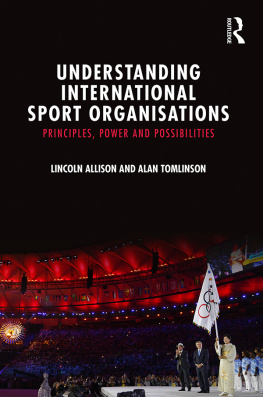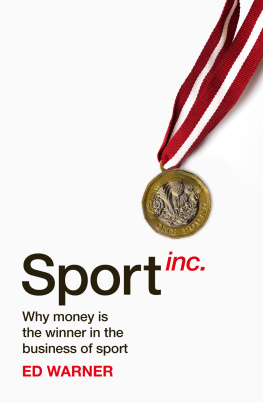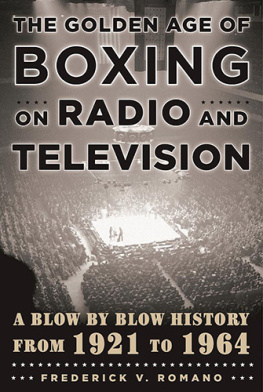Praise for Sit Down and Cheer:
Stacks of insight and humour
***** Four Four Two
A fascinating and irreverent look at the history of sport
on TV insightful and at times humorous Yorkshire Post
Kelner traces the whole fascinating history of TV sport
with a light and often very funny touch Sit Down and Cheer
serves up facts, memories and gossip about everything from
ITV wrestling to the rise of Sky Readers Digest
A book to relish for all those addicted to TV sport
Jon Champion, ESPN
A brilliant history of televised sport Kelner is a very funny writer
Scotland on Sunday
Kelner marries wit with style, solid research and some
good jokes Entertaining Independent on Sunday
An excellent history of sport on TV beautifully vivid its the mix
of misty-eyed nostalgia and hard facts that Kelner delivers so well
**** Rugby World
Witty, and very funny Choice
Comedy and mischievous opinion meet history and
extraordinary research its impossible not to laugh out loud
Peter Drury, ITV Sport
Among the Fans by Patrick Collins
Well Get Em in Sequins by Max Davidson
The Dirtiest Race in History by Richard Moore
Foinavon by David Owen

Contents
1
Not Being There
The trouble with most histories of sport is that they are written by people who were there. Any idiot with a press card dont get me wrong, many of these idiots I count as personal friends can tell you what the atmosphere is like on a big night of European Cup football in the San Siro, or capture the sights and sounds of thoroughbred racehorses charging over the fences at Aintree, or report the collected speeches of gold medal winners at the Olympic games. And any athlete with a decent ghost writer can describe the goals, the runs, the knockouts, the booze, the sex, the drugs, and (for a disturbing number of former tennis professionals these days) the rock n roll.
But to chronicle the last sixty colourful, tempestuous years of sport through the eyes of those who were present at its epoch-making events is to ignore a multi-channel elephant in the corner of the room. Because without the unholy union between sport and television, the sporting landscape we look out on today would be unrecognisable. The story of sport needs to be written by someone who stayed at home and watched, and my credentials are impeccable.
I have made a kind of career out of watching sport on TV. Apologies if that does a disservice to those of you in real careers like medicine, the law, or online pornography, but for the past fourteen years, the Guardian newspaper has paid me to produce a column based, sometimes rather loosely, on televised sport. Before that, I watched a good deal on an amateur basis, going back to the mid-1950s when the whole business started in earnest.
I only realised what an immense social history I was sitting on when I appeared on a discussion programme on BBC Radio Five Live with some much younger contributors and was asked about the build-up to the 1966 World Cup final. What build-up? I was forced to reply. We were excited, of course, largely because there was to be live football on TV, a rarity in those days, but there were no special supplements in the papers, no dedicated sports sections, it did not occupy our every waking moment.
Looking at the TV schedules for Friday 29 July 1966, the eve of the great match, I note the BBC manages a half-hour show, World Cup Report, at 7pm (Meet the teams and the personalities who play tomorrow), allocating precisely twenty minutes less screen time to the Match of the Century than to The Hippodrome Circus, Great Yarmouth, which occupies the peak-time slot at 8pm.
ITV has no World Cup preview at all, scheduling Ready Steady Go against the BBCs meet-the-teams programme. I cant say for certain, but I suspect I may have been watching ITV. As a teenager in 1966, pop music took precedence over almost everything.
Nor was there any great hoop-la on TV after the triumph. The BBC granted Grandstand a whole twenty minutes extra, to round up the momentous events of the day. Had West Germany not equalised in the final minute, we should all have been enjoying the Laurel and Hardy short County Hospital on the BBC by 5.20 (one of the best, as it happens, where Stan brings hard-boiled eggs and nuts to Ollies bedside), followed by Susan Hampshire and others discussing the latest releases on Juke Box Jury. Even less time for post-match hosannas was allowed by ITV, who scheduled Robin Hood at 5.15pm in other words, allocating the World Cup final slightly less time than Sky in 2012 would grant a mid-table Premier League match.
But, of course, we were all busy buzzing round the streets of London in E-Type Jags after the match with Rita Tushingham and Simon Dee, drinking whisky and Coke with Paul McCartney and Jane Asher in Le Kilt Club, or at the very least having a knees-up at one of the many street parties, our Union Jack-bedecked trestle tables groaning under the weight of light ale, pop for the kiddies, and commemorative cakes and pies.
Well, not in suburban Manchester we werent. The Swinging Sixties did not arrive in Manchester until around 1974. Frankly, where we lived it may as well have still been wartime. The air-raid shelters down the bottom of our road had still not been demolished possibly in case of Luftwaffe reprisals for Geoff Hursts dubious second goal and the country, particularly the North, as is customary, was going through the worst economic crisis since the last worst economic crisis.
In the Daily Express on World Cup final morning, the only indication there was a big match on apart from the team news on the back page was a story about the government barring players wives from the postmatch banquet and cocktail party (bunch of Normas and Susans coming down from the North with their beehive hair-dos, who did they think they were? FIFA officials wives were fine, by the way), and a display ad for a hair oil called Vitalis picturing Bobby Moore, and bearing the slogan, The very best of luck England and Bobby Moore. Well be behind you. The lead story was about prime minister Harold Wilsons bibulous economics minister George Brown turning up two hours late for a scheduled TV appearance to explain the governments wage freeze, because he forgot. The Express speculated this might signal the end of his career.
It did not stop the minister getting a seat for the match, though. The documentary feature Goal! World Cup 1966 has a lovely sequence, which cuts from the throng on Wembley Way to the seats armchairs, really being prepared for the VIPs. A tartan rug is spread over the back of each seat, and the name of the dignitary is placed on it: Harold Wilson, George Brown, Sir Stanley Rous, President of the FA, and Her Majesty The Queen of course.Swinging London issue three months earlier, and whatever iconoclasm was implied in British films of the period, deference was still alive and well in 1966 England.
In case you were in any doubt what different times those were, the throng all appear to be wearing demob suits (cheap suits given to military people in advance of their re-entry into civilian life), and sensible shoes buffed up with a decent helping of Cherry Blossom, a million miles away from the baseball-booted, replica-shirted, be-jeaned crowd you might see these days. They did not seem dressed for a party.
As far as the TV coverage went, the 1966 World Cup remains Britains most watched broadcast, with an audience of 32.3 million, just pipping Princess Dianas funeral in 1997, but nowhere was it discussed at the time as a television event. There were TV writers around then notably Philip Purser at the
Next page







